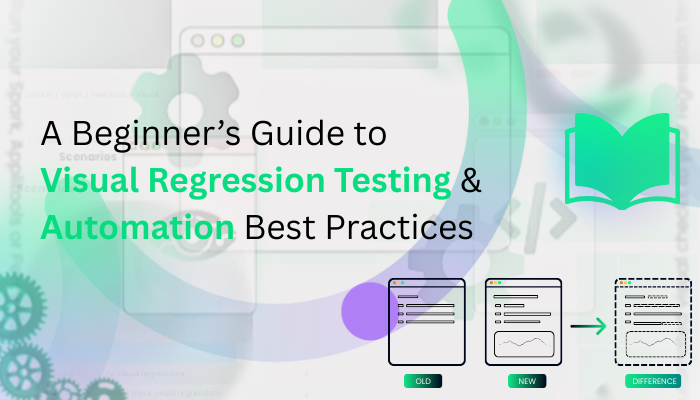A Beginner’s Guide to Visual Regression Testing & Automation Best Practices
When software updates introduce unintended visual changes, they can negatively impact user experience and brand identity. This is where Visual...

When software updates introduce unintended visual changes, they can negatively impact user experience and brand identity. This is where Visual Regression Testing becomes essential. It ensures that UI modifications do not disrupt design integrity across multiple releases.
With the increasing complexity of modern applications, relying on manual testing alone is insufficient. Automated visual regression testing tools streamline this process, allowing teams to detect UI discrepancies effectively.
What Is Visual Regression Testing?
Visual Regression Testing is a quality assurance technique that compares the visual appearance of a web or mobile application before and after changes are made. Unlike functional testing, which focuses on backend logic and user interactions, visual regression checks the front-end layout to detect unintended modifications in UI components.
How It Works:
- Baseline Snapshot: A reference image is captured from the current state of the UI.
- Change Detection: After code updates, a new image is taken and compared with the baseline.
- Difference Analysis: Any pixel variations are identified and highlighted.
- Approval or Fixing: If changes are expected, the new snapshot is accepted. If discrepancies are unintentional, issues are fixed before release.
Why Visual Regression Testing Matters
Visual inconsistencies can arise from code updates, CSS modifications, or responsive design adjustments. These issues may go unnoticed in functional testing, leading to potential UI defects that disrupt usability. Automated visual regression testing ensures UI consistency across different browsers, screen sizes, and devices.
Key Benefits:
- Prevents UI Bugs: Identifies unintended changes before they reach users.
- Ensures Brand Consistency: Maintains design elements across updates.
- Saves Time & Effort: Reduces manual visual verification efforts.
- Enhances Cross-Browser Compatibility: Validates UI across different browsers and devices.
- Facilitates Agile Development: Integrates seamlessly into CI/CD pipelines.
Best Practices for Effective Visual Regression Testing
To maximize efficiency, teams must implement structured testing strategies using visual regression testing tools. Below are key best practices:
1. Select the Right Tools
Choosing an appropriate automated visual regression testing tool is crucial for accuracy and efficiency. Popular options include:
- Applitools: AI-driven image comparison.
- Percy: Integrates with CI/CD workflows.
- BackstopJS: Open-source tool for browser testing.
- Wraith: Suitable for visual diff analysis in web applications.
2. Define Baseline Images Wisely
A strong baseline image set is essential for meaningful comparisons. Ensure that:
- The UI is in a stable state before capturing snapshots.
- Changes to expected elements (e.g., dates, animations) are excluded.
- Screenshots are taken under consistent conditions (browser, viewport size, device type).
3. Implement Automated Testing in CI/CD Pipelines
Integrating Regression Testing in the CI/CD pipeline ensures continuous validation. Automated tests should run:
- After each code commit.
- Before and after deployments.
- During A/B testing phases.
4. Manage Test Failures Efficiently
False positives in regression testing can occur due to minor pixel shifts or dynamic content. To avoid unnecessary alerts:
- Set an appropriate sensitivity threshold for detecting changes.
- Use region exclusion techniques to ignore irrelevant variations.
- Categorize visual changes into expected vs. unexpected.
5. Test Across Multiple Environments
UI elements may behave differently across various browsers and devices. Testing should cover:
- Cross-browser compatibility: Chrome, Firefox, Edge, Safari.
- Device responsiveness: Desktop, mobile, tablet.
- Different resolutions: 1080p, 4K, ultrawide monitors.
Common Challenges & How to Overcome Them
- Visual regression testing, while highly beneficial, comes with its own set of challenges that need to be addressed for optimal efficiency. One of the most common issues is test flakiness, where visual tests produce inconsistent results due to variations in rendering, browser behaviors, or environmental factors. This can be mitigated by stabilizing the test environment, using headless browsers, and maintaining consistent rendering engines.
- Another significant challenge is handling dynamic content, such as rotating banners, date-time elements, or user-generated data. These elements change frequently and can lead to false positives in test results. A practical approach is to mask dynamic content using test-specific CSS overlays or configure exclusion zones to ignore these fluctuating areas during comparisons.
Future of Visual Regression Testing
As UI complexity increases, regression testing tools continue to evolve with fAI-powered analysis, self-healing test automation, and enhanced cloud-based integrations. Businesses adopting robust automated regression testing frameworks will benefit from faster development cycles and improved UI consistency.
Conclusion
Adopting Visual Regression Testing is essential for businesses aiming to maintain seamless UI consistency while iterating their applications. Leveraging regression testing tools and integrating automated regression testing into CI/CD workflows ensures a more stable and visually accurate user experience. By following best practices and overcoming common challenges, organizations can achieve a streamlined, error-free UI testing process.
For Read More Articles You Can Explore this Keyword Also : thenewsus.com






